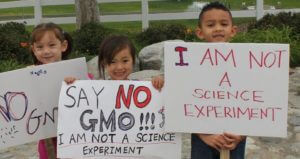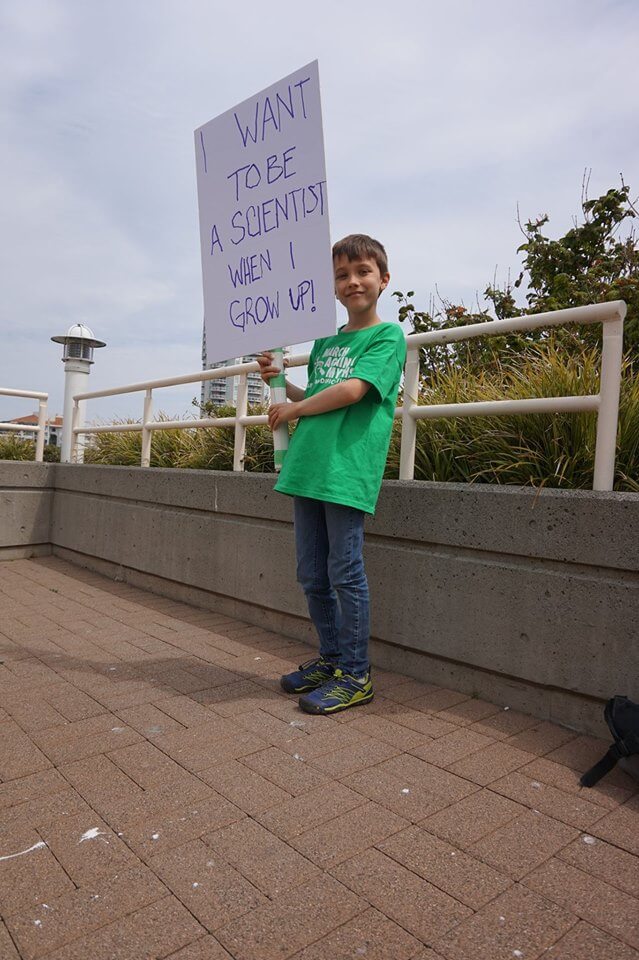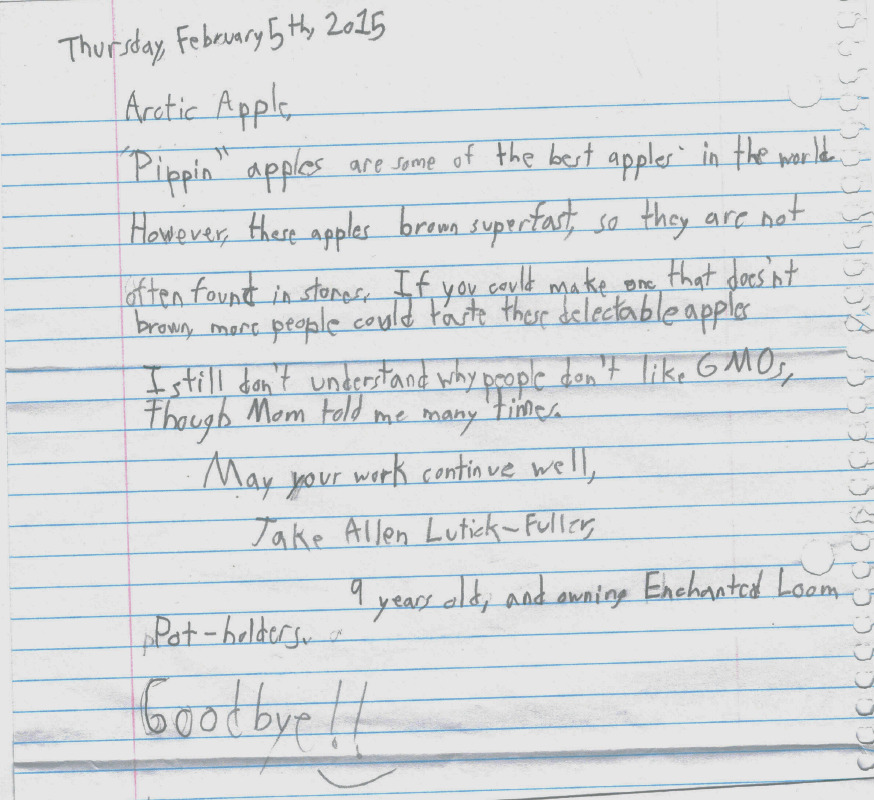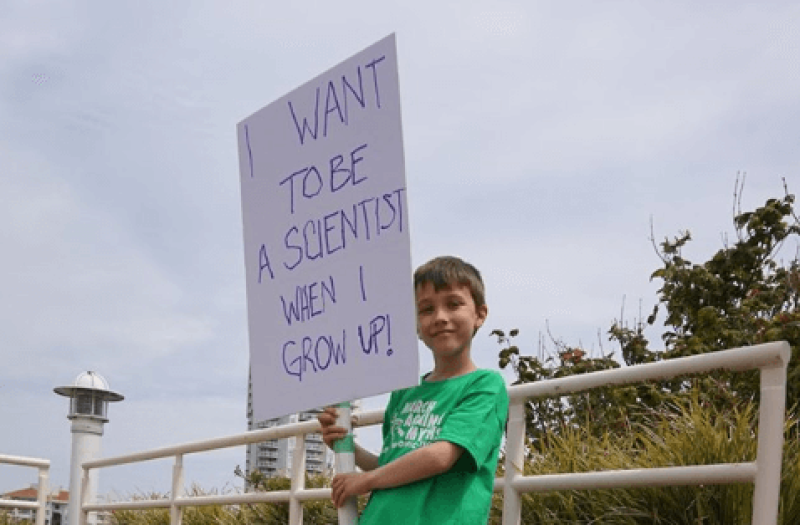As clichéd as it sounds, and although we don’t reflect on it often, we can all agree that our future depends on children. Indeed, classic songs like “I Believe the Children are Our Future,” and “Teach Your Children Well” speak to the importance of giving youth the foundation to think independently, thrive and contribute. But avoiding indoctrination of children is a challenge.
Adults have indoctrinated children since pre-historic times into mini-ideologues, with dogmas ranging from politics, to religion, and now to anti-science zealotry. It’s truly saddening to see it firsthand. Excepting religion, some of the most in-your-face child indoctrination happens annually at March Against Monsanto events.
The MAM movement began in 2013 as a grassroots response to the failure of California proposition 37, a ballot initiative that would have required labeling of foods made with genetically engineered ingredients. MAM started as an anti-GMO movement but has since evolved into a full-blown promoter of conspiracy theories ranging from chemtrails to anti-vax, to “mental illness is caused by inflammation” varieties. Backed by the organic and “natural” food activists, and with visions of syringe-laden frankenfoods and cackling corporate bigwigs dancing menacingly in their heads, hundreds of thousands of concerned protesters gather around the world annually to march.
And they bring their children. Kids as young as five and six pepper the MAM crowd holding signs bearing messages like “Stop poisoning me!” and “I am not a science experiment.”

Sadly, some of these children and adults might be too far gone to reach with evidence and truth. Fortunately, there are plenty of middle ground, rational folks on the fence about biotechnology in agriculture. It’s these fence-sitters that the new “March Against Myths” organization aims to reach. Founded as a grassroots response to March Against Monsanto, MAMyths held its first international counter-protest on May 23, 2015. The group’s high level objective is to offer science-based facts to counter fear mongering and misinformation about biotechnology, GMOs, and other scientific issues.
As reports trickled in from chapter events worldwide, one common theme emerged: MAM protesters were vitriolic, rude, and irrational, while MAMyths members were approachable, friendly, and rational. MAMyths held signs like “Facts, not fear!”, “GMOs saved the Hawaiian Papaya,” and “Farmers never sued for cross-pollination.” In stark contrast, MAM’s signs were full of expletives and deluded messaging like, “F*** Monsanto,” “Stop poisoning Americans,” “OMG, GMO, WTF,” and even anti-vax signs, middle finger images, and chemtrail conspiracies.
The rage was palpable at the Chicago event, which I attended with other MAMyths co-founders, Dr. Karl Haro von Mogel and David Sutherland. While the anger was depressing though bearable from adults, it was truly heartbreaking coming from the mouths of babes. When Karl and I ventured into a throng of MAM protesters, our green MAMyths shirts prominent against their red, the anti-GMO crowd was riled up and eager to pounce. A large man got about a foot from my face and shouted that I was scheming to take over the food system. He was so agitated, I could see the saliva spray from his lips, feel it land on my face. The small mob kept shouting “who’s paying you? Why are you here?” Perhaps I should have remained quiet, but I couldn’t help it. I calmly stated, “Nobody is paying me. I’m a writer, a science activist, and a mom of two.”
A 13-year-old boy who had been listening and supporting the hecklers stepped forward. His face contorted in fury, he shouted at me, “You’re killing your children!” Saddened, I simply shook my head. The child thought I was arguing with him and he repeated, “Yes you are, you’re killing your children! You’re poisoning them!” I turned my back. I couldn’t argue with an indoctrinated child.
Frankly, it’s practically impossible to sway anti-GMO zealots like March Against Monsanto members. Our hope is that by counter-protesting zealots, the attention we garner on social media and in the news will help reach observers, not extremists. We hope to sway fence-sitters, not ideologues who can’t be reached.
Young anti-biotechnology activists-in-training have a role model, someone to sway them to the ideological side of the fence when they’re the most ripe for picking. Rachel Parent is a 16-year-old Canadian and well-known anti-GMO activist who founded “Kids Right to Know” at age 12. The energy and trustworthiness that often accompanies youth has taken Ms. Parent to dizzying heights. For the past few years, Parent has spent her time speaking publicly, making television appearances, spreading misinformation about biotechnology, and mingling with the who’s who of food woo. She’s posed for pictures with anti-GMO glitterati ranging from Food Babe to Jeffrey Smith to Vandana Shiva.

And her messaging is hugely inaccurate. Simply reach into the propaganda grab-bag that is the Kids Right to Know website; the patently false rhetoric is abundant. Just one of the many popular myths Parent promotes on her website? That GMO strawberries contain fish genes. This is demonstrably inaccurate on two counts: First, there are no transgenic “GMO” strawberries on the market. Second, while scientists have researched fish genes in tomatoes, there are no GMOs with animal genes available to consumers. Claim debunked in two sentences. Feel free to peruse the website for more fallacies.
Fortunately, now rational folks have their own poster child. For those who choose to judge biotechnology based on evidence and scientific consensus rather than fear and myths, look no further than the fresh-faced, intelligent, and poised Jake Lutick-Fuller.

Jake Lutick-Fuller isn’t your run-of-the-mill science enthusiast with a volcano at the science fair. Also Canadian like Rachel Parent, the 10-year-old mushroom aficionado likes to trek through the forest weekly, observing the biology and ecology of plants and fungi in the Nanaimo, British Columbia area. He has a passion for genetic engineering, and aspirations to become a scientist. Jake, who knows the Latin name for almost any fungus, used his sharp intellect to convince his parents Joshua and Heidi to allow him to accompany them to their local MAMyths event. Though his mom and dad were wary, the finally allowed him to attend. Jake’s father explained,
“We debated long and hard with him on the subject of children at protests. He would have none of it. He countered every single one of our arguments and I played the other side on him hard so that he could see how bad it could be, and he totally held his own. He insisted on a shirt and insisted that he go. He cares as much about this issue as we do and I think that he’s actually old enough at this point to make his own decision on the issue. I’ve played the other side with them several times and he’s always quick to catch on.”
Jake’s answers to the questions below show that the future scientist deserves our respect not only as a brilliant, level-headed, child but as an intelligent, rational, and kind individual.
[Editor’s note, Jake Lutick-Fuller wrote these answers himself. His father added the citations after fact-checking Jake’s responses.]When did you decide you want to be a scientist?
I decided I wanted to be a scientist because everything I like is formed by science. I started out with wanting to be a mycologist. I still do, really. Then I learned about botany, which was also really cool: the study of plants and how amazing they can be, like the mimosa plant which seems to curl up in fright at the slightest touch. I started doing foraging with a biologist and learned all I could about mushrooms and plants like the cardamine bittercress genus and the prince agaricus mushroom. Last year I was learning about gathering pine pollen and mom told me about the pestiferous mountain pine beetle. I wanted to genetically modify a pine tree to be poisonous to the pine beetle so I sent a letter to Monsanto asking if they could genetically modify a pine tree and that was when I decided I wanted to get into biotechnology.
Your parents seem very supportive of your aspirations. How do they help you pursue your interests?
It was mom and dad who told me to write the letter to Monsanto. They also told me I should send a letter to Arctic Apples. Mom also found me the foraging class I go to now. They help me find information about my interests and think skeptically.

I understand you want to work with pine trees. What’s the problem with pine trees, and do you think it can be solved?
The problem with pine trees is that recently they’ve fallen prey to a little beetle called the Mountain Pine Beetle. This little bug has been killing the forests of pine trees and turning the trees red. The problem is that this beetle has grown particularly common due to global warming which is heating up the planet and normally the beetles are killed by extreme cold but the winters are warmer and the beetle isn’t killed by them anymore. The other thing that kills them is heat but forest fires are equally devastating. I think we should kill them with their own food. I thought we could genetically modify a pine tree so that its wood could produce something that is toxic to the beetles. One helpful thing is that Oregon State University and the University of British Columbia have sequenced the genome of the fungus that causes the blue dye that helps the beetle kill the tree. The mountain pine beetle particularly likes this pinus contorta, or lodgepole pine. We could modify the pine tree’s genome so that it produces something that is unfavorable to beetles and kills them.
What are your favorite advances in genetic engineering so far?
My favorite advances in genetic engineering so far is the creation of Arctic apples. Seriously! Apples that don’t brown are good because I don’t have to have rotten looking brown apples in my lunchbox. I also think that the genetic engineering of the e. coli bacterium to produce insulin was special because e. coli is regularly horrible to you so now it’s being used for something helpful. My uncle has diabetes and this particular advancement helped him.
Why did you decide to attend MAMyths?
Because I think that biotechnology is really cool and so I really don’t understand why people would not like it. However, now I know that it’s because people are scared, but still: you can overcome your fears with a little help. I also think that the people from Monsanto seem really nice and that marching against it isn’t so nice. When I wrote my letter to Monsanto they said that they mainly didn’t do trees but they helped me find other places that did. They sent me a nice letter and were really nice and included an answer to a question I had included about sweet corn that grows in small spaces.
What was the most memorable experience at MAMyths/March Against Monsanto?
Well, I think the coolest part was probably around the beginning when that guy (a reporter) asked to take pictures of us with our signs. When we were marching on the sidewalk someone asked us if she could have a picture with me holding my sign. She wanted to have a picture because her roommate was studying biology and she thought he might appreciate a picture of me with my sign. It said “I want to be a scientist when I grow up”.
What did some MAM participants say to you?
Well, near the end there was some 63 year old woman who yelled at me for thinking that Monsanto was “just a company”. She said that Monsanto is trying to get hold of the government! How can it be just a company? When I asked her “where did you hear that? From the internet?” she said “young man, I am 63 years old and I have learned a lot in my lifetime.” Mainly the others were nice except for one of them who gave me a scowl as if I was a lemon genetically modified to be sour.
Are you familiar with teenage anti-GMO activist Rachel Parent? If so, what are your thoughts about her message and her approach?
Kind of. I’ve looked at her website a bit and I think that there’s a lot of misinformation on it. For example, she says that a GMO is taking genes from one species and inserting them into another to produce desired traits, but there are plenty of other ways. For example, the arctic apple uses apple genes and not fish genes. Also she says the traits achieved by genetic engineering would not be possible in nature, but that’s not exactly true. Nature can do its own genetic engineering through evolution. A fern acquired genes from a primitive plant called hornwort that allowed it to sense low levels of light which allowed it to grow on a shady forest floor.
I’ll be following Jake Lutick-Fuller in the years to come. As Joel of Okanagan Specialty fruits wrote after receiving his fan mail, the kid has big things in his future!
Note: Rachel Parent could not be reached for comment
Kavin Senapathy is a contributor at Genetic Literacy Project, Skepchick, Grounded Parents, and other sites. She is a mother of two, science popularizer, and freelance writer in Madison, WI. Contact and follow Kavin on her science advocacy Facebook page and Twitter @ksenapathy
Additional Resources:
- Call for action: It’s time to March Against the March Against Monsanto, Genetic Literacy Project
- 10 studies proving GMOs are harmful? Not if science matters, Genetic Literacy Project
- GLP Infographic: Is labeling GMOs really about our “Right to Know”? Genetic Literacy Project































